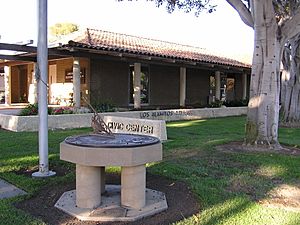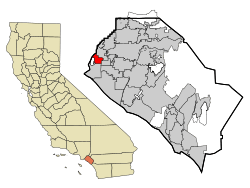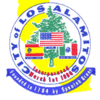Los Alamitos, California facts for kids
Quick facts for kids
Los Alamitos, California
|
|||
|---|---|---|---|

Los Alamitos City Hall
|
|||
|
|||

Location of Los Alamitos within Orange County, California.
|
|||
| Country | United States | ||
| State | California | ||
| County | Orange | ||
| Incorporated | March 1, 1960 | ||
| Government | |||
| • Type | Council-Manager | ||
| Area | |||
| • Total | 4.07 sq mi (10.55 km2) | ||
| • Land | 4.01 sq mi (10.39 km2) | ||
| • Water | 0.06 sq mi (0.16 km2) 1.60% | ||
| Elevation | 23 ft (7 m) | ||
| Population
(2020)
|
|||
| • Total | 11,780 | ||
| • Density | 2,894/sq mi (1,116.6/km2) | ||
| Time zone | UTC-8 (PST) | ||
| • Summer (DST) | UTC-7 (PDT) | ||
| ZIP codes |
90720-90721
|
||
| Area code(s) | 562 | ||
| FIPS code | 06-43224 | ||
| GNIS feature ID | 1652748 | ||
Los Alamitos (Spanish for 'The Little Cottonwoods') is a city in Orange County, California. It became an official city in March 1960. In 2020, about 11,780 people lived here. This was a small increase from 11,449 people in 2010.
The nearby area called Rossmoor uses the same mailing ZIP code (90720). But it is not actually part of Los Alamitos. The Los Alamitos Race Course is named after the city. However, it is located in the next-door city of Cypress.
The USA Water Polo National Aquatic Center is also found in Los Alamitos. It is located at the Joint Forces Training Base - Los Alamitos.
Contents
History of Los Alamitos
Long ago, Native Americans lived in the area that is now Los Alamitos.
The city of Los Alamitos was started in 1896 by Lewellyn Bixby. He wanted to support a new sugar beet factory. This factory was built by the very rich Clark Brothers. William Andrews Clark was a future Senator from Montana. He made his money from mining, banking, and logging. His younger brother, J. Ross Clark, managed their California businesses.
Lewellyn Bixby's family owned the land around the factory. He had wanted to build a sugar beet factory for years. But he didn't have enough money after some losses in the 1880s. So, he teamed up with William A. Clark. Clark provided the money, and E.A. Dyer provided the knowledge to build the factory.
The town grew around this new sugar beet factory. It had streets with houses for workers and farms nearby. This community became known as Los Alamitos. As part of the deal, William Clark and his brother J. Ross also got 1,000 acres of land. Later, they bought 8,000 acres more. This land eventually became the Long Beach Airport and the city of Lakewood. The Clarks also helped build a railroad from Los Angeles to Salt Lake City. They even created the desert stop of Las Vegas.
In the early 1900s, farmers brought sugar beets to the factory by horse and wagon. But by 1921, the sugar beet industry in Orange County started to decline. This was due to economic changes and insect problems. The sugar beet factory in Los Alamitos eventually closed. However, the town kept growing.
South of the factory, Fred H. Bixby used his land for cattle. He would fatten them up before sending them to be processed. He was a forward-thinking rancher. He allowed European, Mexican, and Japanese farmers to rent his land and grow crops. During World War II, the Japanese farmers were forced to leave their homes. They were moved to special camps, like Manzanar.
Before and during World War II, Los Alamitos became important for the aircraft industry. The Clark family helped Donald Douglas build an aircraft plant near the Long Beach airport. The Navy also needed an airfield for training. So, in August 1940, a new airfield was built east of Los Alamitos. This was the first military base in Orange County.
In February 1941, the Navy decided to move all its reserve aviation training here. They bought a 1,300-acre area. The new base created many jobs and helped the town grow. After World War II, the base was very busy, especially during the Korean War. But by the late 1950s, more homes were built nearby. This made the base less active. The Navy left in 1972. In 1973, the California National Guard took over the base. Today, it supports units from the Army, Navy, National Guard, and Marines. It also hosts other government groups like Homeland Security.
Many former military members decided to stay in Los Alamitos after the war. They lived in new neighborhoods like Carrier Row. The streets there are named after World War II aircraft carriers. These carriers were often home to Navy pilots trained at Los Alamitos. Carrier Row was built in different parts between 1947 and 1955.
In 1956, a builder named Ross Cortese bought land to create Rossmoor. This was a new community just southwest of Los Alamitos. Rossmoor was the first "walled community" in the United States. It quickly became home to over 10,000 professionals.
Even though Rossmoor is not officially part of Los Alamitos, they are closely connected. When Los Alamitos became a city in 1960, it had about 3,400 people. Rossmoor was growing and had almost 10,000 people. Today, both areas have similar populations. Rossmoor residents don't pay taxes to Los Alamitos. But the city treats them like residents. In return, many Rossmoor residents volunteer for the city's youth programs. Also, Rossmoor has few businesses, so its residents often shop in Los Alamitos. This brings sales tax money to the city.
The success of Rossmoor led to more new neighborhoods in Los Alamitos. These included Dutch Haven (1960), Rossmoor Highlands (1961), and College Park North (1967).
Today, Los Alamitos is a small city. Most of its land is already developed. About 48% of the city's land is taken up by the Armed Forces Reserve Center. The rest of the city is a mix of homes, apartments, businesses, and open spaces.
Los Alamitos has been home to many famous athletes. These include baseball Hall of Famer Bob Lemon and Olympic gymnast Cathy Rigby. The Los Alamitos youth baseball leagues started in 1958. They have helped many players reach the major leagues. Some of these include Robb Nen and J. T. Snow. The area is also home to record-holding long-distance swimmer Lynne Cox.
Geography of Los Alamitos
Los Alamitos is surrounded by other cities. To the north and east is Cypress. To the east is West Garden Grove. To the south is Seal Beach. The area called Rossmoor is almost completely surrounded by Los Alamitos.
The city also shares a border with Long Beach in Los Angeles County. This is near the El Dorado Park area. Coyote Creek acts as a natural border between Los Alamitos and Long Beach.
Climate
Los Alamitos has a mild climate. Gardeners use special zones to know which plants will grow well. The USDA Hardiness Zone for Los Alamitos is 9. The Sunset climate zone is 22.
| Weather chart for Los Alamitos, California | |||||||||||||||||||||||||||||||||||||||||||||||
|---|---|---|---|---|---|---|---|---|---|---|---|---|---|---|---|---|---|---|---|---|---|---|---|---|---|---|---|---|---|---|---|---|---|---|---|---|---|---|---|---|---|---|---|---|---|---|---|
| J | F | M | A | M | J | J | A | S | O | N | D | ||||||||||||||||||||||||||||||||||||
|
3
68
46
|
3
68
48
|
2.4
69
50
|
0.6
73
53
|
0.2
74
58
|
0.1
78
61
|
0
83
65
|
0.1
85
66
|
0.2
83
64
|
0.4
79
58
|
1.1
73
50
|
1.8
69
45
|
||||||||||||||||||||||||||||||||||||
| temperatures in °F precipitation totals in inches source: Weather.com / NWS |
|||||||||||||||||||||||||||||||||||||||||||||||
|
Metric conversion
|
|||||||||||||||||||||||||||||||||||||||||||||||
Population of Los Alamitos
| Historical population | |||
|---|---|---|---|
| Census | Pop. | %± | |
| 1960 | 4,312 | — | |
| 1970 | 11,346 | 163.1% | |
| 1980 | 11,529 | 1.6% | |
| 1990 | 11,676 | 1.3% | |
| 2000 | 11,536 | −1.2% | |
| 2010 | 11,449 | −0.8% | |
| 2020 | 11,780 | 2.9% | |
| 2023 (est.) | 11,901 | 3.9% | |
| U.S. Decennial Census 1860–1870 1880-1890 1900 1910 1920 1930 1940 1950 1960 1970 1980 1990 2000 2010 2020 |
|||
2020 Census Information
In 2020, Los Alamitos had a population of 11,780 people.
- About 46.26% of the people were White (not Hispanic).
- About 2.95% were Black or African American.
- About 17.49% were Asian.
- About 25.69% were Hispanic or Latino (who can be of any race).
- Other groups made up smaller percentages of the population.
2010 Census Information
The 2010 census showed Los Alamitos had 11,449 people.
- About 71% of the people were White.
- About 12.8% were Asian.
- About 2.8% were African American.
- About 21.1% of the people were Hispanic or Latino.
Most people (97.9%) lived in homes. The average household had 2.66 people. About 38.2% of homes had children under 18. The median age in Los Alamitos was 38.7 years old. The median household income was $80,449. About 7.2% of the population lived below the poverty line.
Economy of Los Alamitos
Los Alamitos is home to several businesses. The first Claim Jumper restaurant opened here in 1977. That location is now a Hof's Hut. Neverland Studios, a recording studio, was also originally in Los Alamitos. Tillys had its first store here too.
Top Employers
Here are some of the biggest employers in Los Alamitos, based on a 2022 report:
| # | Employer | # of employees |
|---|---|---|
| 1 | UCI Health - Los Alamitos | 1,100 |
| 2 | Arrowhead Products | 780 |
| 3 | Trend Offset Printing | 700 |
| 4 | Epson America | 693 |
| 5 | Mittera California, Inc. | 238 |
| 6 | Discovery Practice Management, Inc | 205 |
| 7 | Bar Bakers, LLC | 200 |
| 8 | Resare Marketing, Inc | 191 |
| 9 | Alamitos West Health & Rehabilitation | 145 |
| 9 | Evergreen Pharmaceutical of California, Inc. | 145 |
| 9 | Katella Delicatessen-Restaurant-Bakery, Inc. | 145 |
Notable People from Los Alamitos
Many well-known people have lived in or have connections to Los Alamitos:
- Dana Andrews, actor
- Aaron Barrett (born 1974), musician from the band Reel Big Fish
- Jonathan Bornstein (born 1984), soccer player for the USA National Team
- Kami Cotler (born 1965), actress
- Lynne Cox, famous long-distance swimmer
- Troy Edgar, American security official
- Landry Fields, basketball player for the New York Knicks
- Scott Klopfenstein, musician, former member of Reel Big Fish
- Chris Kluwe, former punter for the Minnesota Vikings
- Bob Lemon, baseball Hall of Famer (pitcher and manager)
- Marcedes Lewis, tight end for the Green Bay Packers
- Allison Mack, actress (known as "Chloe" from Smallville)
- Taryn Manning (born 1978), actress
- Matthew Morrison, singer and actor (from Broadway and Fox TV's Glee)
- Tony Muser, former MLB player and manager
- Robb Nen, baseball player
- Cathy Rigby, Olympic gymnast and actress
- Matt "Money" Smith, Fox Sports Radio talk show host
- J.T. Snow (born 1968), baseball player
- Jodie Sweetin, actress ("Stephanie Tanner" from Full House)
- Ralph Flanagan (swimmer), Olympic swimmer
- Nikki Monninger, bass guitarist for Silversun Pickups
Schools in Los Alamitos
Los Alamitos is part of the Los Alamitos Unified School District. This district started in 1898 as Laurel Elementary School District. It changed its name in 1953 to Los Alamitos Elementary School District. It used to only teach students up to sixth grade. For grades 7-12, students went to schools in the Anaheim School District. In 1979, voters decided to create the Los Alamitos Unified School District. This brought all local grades under one system.
Schools in the district include:
- Los Alamitos High School (opened in 1967)
- McAuliffe Middle School (originally Pine Jr. High)
- Oak Middle School (originally Oak Jr. High)
- Hopkinson Elementary in Rossmoor, California
- Lee Elementary in Rossmoor, California
- Los Alamitos Elementary
- Rossmoor Elementary in Rossmoor, California
- Weaver Elementary in Rossmoor, California
- St. Hedwig School, a private school for grades K–8
See also
 In Spanish: Los Alamitos para niños
In Spanish: Los Alamitos para niños





